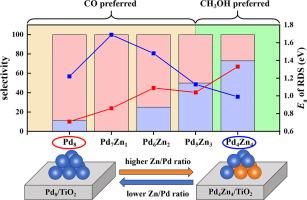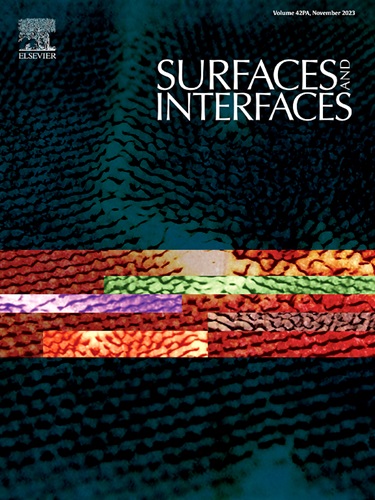在 PdZn/TiO2 上选择性活化二氧化碳制甲醇的第一性原理研究:揭示锌/钯比例对催化性能的影响
IF 5.7
2区 材料科学
Q2 CHEMISTRY, PHYSICAL
引用次数: 0
摘要
本研究通过密度泛函理论(DFT)研究了一系列 Pd(8-n)Znn/TiO2(n=0-8),以了解 Zn/Pd 比率对其将 CO2 转化为甲醇的催化性能的影响。结果表明,当 Zn 在组成中的摩尔浓度增加时,它更倾向于取代底层的 Pd。在所有表面模型中,团簇和支撑物之间的界面在二氧化碳的稳定和活化中起着关键作用。提高 Zn/Pd 比率会削弱二氧化碳在催化剂上的结合强度,从而进一步阻碍 "RWGS "途径,促进 "甲酸盐 "途径。根据计算结果,建立了两种机理中关键基本步骤的活化势垒(Ea)与关键中间产物结合强度之间的布伦斯特-埃文斯-波兰尼(BEP)关系,并据此确定了催化性能最佳的最佳 Zn/Pd 比。此外,研究还发现,尽管水对羟基形成步骤有促进作用,但在体系中加入水对速率决定步骤的 Ea 变化不大。总之,这项工作就簇组成对 PdZn 基催化剂催化性能的影响提供了一些有意义的见解,并为合理设计支撑双金属催化剂提供了有价值的信息。本文章由计算机程序翻译,如有差异,请以英文原文为准。

First-principles study of selective CO2 activation to methanol on PdZn/TiO2: Unveiling Zn/Pd ratio on catalysis performance
In this study, a series of Pd(8-n)Znn/TiO2(n=0–8) were investigated via density functional theory (DFT) to understand the influence of Zn/Pd ratio on their catalysis performance of conversion CO2 to methanol. It is revealed that Zn prefers to replace the bottom-layered Pd when its molar concentration in composition increases. For all surface models, interface between cluster and support plays a key role in CO2 stabilization and activation. Increasing Zn/Pd ratio could weaken the binding strength of CO2 over catalyst, which further hinders the “RWGS” pathway while promotes the “Formate” pathway. Based on the calculation results, a Brønsted–Evans–Polanyi (BEP) relation between the activation barrier (Ea) of key elementary steps from both mechanisms and the binding strength of key intermediates has been established, from which the optimum Zn/Pd ratio leading to the best catalysis performance has been determined. Moreover, it is found that water inclusion in the system does not change the Ea of rate-determining step much even though it has a promotion effect on O![]() H formation steps. Overall, this work provides some meaningful insight into the influence of cluster composition on the catalysis performance of PdZn-based catalyst and provides valuable information about rational design of the supported bimetallic catalyst.
H formation steps. Overall, this work provides some meaningful insight into the influence of cluster composition on the catalysis performance of PdZn-based catalyst and provides valuable information about rational design of the supported bimetallic catalyst.
求助全文
通过发布文献求助,成功后即可免费获取论文全文。
去求助
来源期刊

Surfaces and Interfaces
Chemistry-General Chemistry
CiteScore
8.50
自引率
6.50%
发文量
753
审稿时长
35 days
期刊介绍:
The aim of the journal is to provide a respectful outlet for ''sound science'' papers in all research areas on surfaces and interfaces. We define sound science papers as papers that describe new and well-executed research, but that do not necessarily provide brand new insights or are merely a description of research results.
Surfaces and Interfaces publishes research papers in all fields of surface science which may not always find the right home on first submission to our Elsevier sister journals (Applied Surface, Surface and Coatings Technology, Thin Solid Films)
 求助内容:
求助内容: 应助结果提醒方式:
应助结果提醒方式:


